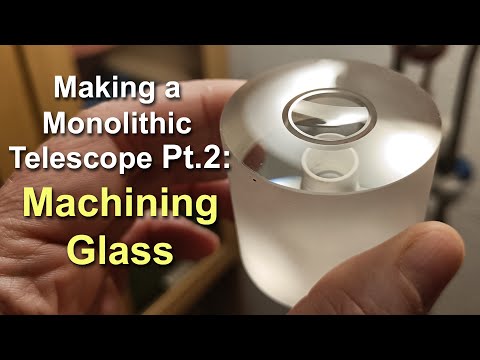Making a Monolithic Telescope Part 2: Machining Glass

Hey everyone, Today’s video is about manufacturing a monolithic Cassegrain telescope, so a telescope made from a single solid piece of glass. This is actually the second video of a series. The first video was about the optical design and in case you missed it, you might want to watch that one first, because it contains important theoretical background information.
In the current video I will focus on the practical aspects of making the actual device, at least the easy part. This includes the drilling, milling, grinding and the preliminary polishing of the glass surfaces. And in an upcoming video, I will focus on the hard part of this project which is the manufacture of accurate aspherics. So, in the last video, I considered two possible configurations to make: the classical Cassegrain and the Schmidt-Cassegrain. Both these designs contain 2 optical surfaces that are aspherical. From the viewpoint of manufacturing, I guess these two configurations are more or less comparable in difficulty and for this video, I chose to discuss the classical Cassegrain version.
Just as a reminder, let me quickly summarize the configuration of the Cassegrain: the standard Cassegrain, made with two separate mirrors, consists of 2 aspherical surfaces, a parabolic primary mirror and a hyperbolic secondary mirror. Light enters the telescope from the left, is reflected by the two mirrors and is then focused behind the primary mirror to an image. Now, in the monolithic equivalent, the light enters the telescope through a flat glass surface indicated as R1. It then reflects on the back surface R2 which acts as the primary mirror.
This surface is coated on the outside with a thin reflective coating of silver or aluminium and it returns the light onto a secondary mirror R3, which is also coated with a reflective layer. R3 then reflects the light through an aperture in the primary mirror onto a focal plane. In the design that was previously discussed, the aperture R4 is not just a flat surface but is concave. And his increases the focal length of the system a bit.
So, this table gives a summary of the dimensional specifications taken from the optical design process in the previous video. One thing that I did not discuss in the previous video was baffles. If we place a detector in the image plane behind the telescope, stray light entering the telescope under an angle can directly reach the detector and this can have a big effect on the image contrast.
Now, in a standard Cassegrain design we have additional tubes that block stray light from reaching the image plane. And in a solid piece of glass, we can recreate a simple equivalent of these tubes by drilling the shape of the baffles directly into the glass using a hollow drill. We can then coat the drilled shapes with black paint on the inside. And with this fairly small modification we can make a full working Cassegrain. So, this is what we are trying to make: all in all, it’s a pretty complex part and there are actually a lot of pitfalls.
But in my opinion, the best thing is just go ahead and learn as much as possible along the way. [DRILLING] The first step in making the part is drilling a glass cylinder from a block of crown glass and this sounds pretty straight-forward. But for drilling glass you need specialized tooling. For example, a hollow diamond drill of the right diameter and sufficient length.
To drill out a 50mm diameter glass cylinder, I used a diamond drill with an outer diameter of 52mm and a wall thickness of 1mm. This type of drill requires the use of water cooling, otherwise the diamonds in the drill and the glass will get damaged very quickly. So that is why we need a drill adapter that can supply cooling water to the drill. Because of the cooling water requirement, we also need a collecting tray for the excess water and preferably some kind of splash screen around the drilling area.
Otherwise, we are in for wet adventure. For supplying the cooling water, I used a circulation system consisting of just a bucket and a circulation pump. Now, you cannot just put the glass block under the drill and start drilling.
That is because of the nature of the diamond drilling process. In diamond machining we need a lot of pressure on the tool and the diamonds create cracks in the glass during contact, which then release glass particles. And the combination of the pressure and the crack formation can lead to very nasty break out of glass at the point of exit.
The way that this can be avoided is by temporarily gluing the glass block to a thick support plate at the drill exit point, and generally this plate is also made of glass. For bonding the two together we use something called blocking wax. The blocking process is done by heating both the object and the blocking plate in an oven to about 70-80 degrees Celsius. The two pieces are then pressed firmly together with some wax in between and then cooled down to let the wax solidify. So, when we make a drill now, we get a nice clean cut on the back side of the block. When finished, we heat everything up, the wax melts again and the sample can be deblocked and cleaned.
Now, it is vital that after drilling at least one of the surfaces is nicely perpendicular to the core drill. And this surface will be the front window of the telescope. We can check this by for example using a right-angle tool. The center of the glass core will be the optical axis in the device, so with every step we take from here on, we need to make sure that our modifications are well aligned to the optical axis, which means also to the outside surface of this cylinder.
[RADIUS MILLING] The resulting glass cylinder is a few mm longer than the telescope length and the next step would be to make the other surfaces at the appropriate distances from each other and with the right curvatures. And for this we can use a technique called radius milling. I’ve actually discussed radius milling in quite some detail in another video, so I’ll place a link in the description. Here I will keep it very brief: radius milling of glass generally works by placing a hollow diamond milling tool under an angle and then rotate the sample, while gradually milling away material. And the curvature in the substrate is dependent on the position of the mill with respect to the center of the sample, making it either convex or concave.
But the exact radius that results is really dependent on the angle of the mill, and the diameter of the tool. Our current design has 4 optical surfaces, each with a very different radius of curvature. On top of that, two of these are aspherical. Now, at first glance you might think, let’s just go ahead and use the radiay in the table. But generally speaking, that is not a good idea. Let me shortly explain why.
Here is a pretty extreme example of a hypothetical aspherical surface and indicated is the radius of curvature as defined in the optical design. If we were to start the manufacture of this surface by just using the value of the current radius, you see that we run into trouble because we have removed too much material and there is no way that we can get back to the required shape. So instead, we need to use a different approach, which is based on finding the so called “best fit sphere” of BFS as a basis for making the aspheric. If we first generate a best fit sphere surface, we can then still get to the required asphere by the subsequent removal of a small amount of material in the appropriate locations.
And of course, the idea is that this BFS is chosen in such a way that, later on, only the minimum amount of material has to be removed. Now for this extreme example, the difference between the radius of curvature and BFS is pretty obvious. But in the case of the monolithic telescope, the asphericity is much less extreme. Take for example the parabolic primary mirror surface R2 which has a radius of 120.6mm. We can plot the surface sag of this surface as a function of the radial distance from the optical axis and if we do that we get a plot like this. Here’s the same plot but I’ve blown up the vertical scale a bit, otherwise it is difficult to see the point I’m trying to make here.
So, the curve of the surface sag of a conical surfaces is described by this formula and if we now calculate the corresponding curves for the sphere with a conic of 0, and the parabola, with a conic of -1, the maximum difference between the two shapes is found on the outer perimeter of the curve and is only around 28 um. This is about half the thickness of a human hair, which sounds like fairly insignificant, right? But if you look at the two shapes in this case, you see that the parabola requires the removal of less material than the sphere. So even in this case, it is better to create the parabola from a best fit sphere with a somewhat different radius value than the radius of curvature. Let me show you a fairly easy way to find the best fit sphere using an excel sheet: we can use the formula for a conical shape to calculate the sag in the surface shape for a number of radial distances from the optical axis. By the way, you can download this sheet from a link in the description, if you feel the urge to do this yourself and make your own asphere.
The sheet contains 2 examples, which are the primary and the secondary from the current design. It has a few key input fields that allows us to fill in the original radius of curvature and the conic constant taken from the design. And in this graph, the difference in surface shape between sphere and the conical shape is shown. In the graph you can barely make out the maximum difference of the 28 microns, which were mentioned before, here at the outer edge of the surface. Now, you can also fill in another value for the sphere in this field, and this allows you calculate how much material you need to remove and where, when going from this radius to the required asphere.
Since we want to find the Best fit Sphere and want to limit the removal of material a minimum, we can try different values to find the best fit. And it turns out that if you choose 121,9mm, you only need to remove around 7 microns of glass thickness max in the surface profile shown here. By the way, this sheet is not only useful when we want to find the value of a best fit sphere, but it also allows us to see how much material we need to remove and where, if we start from a somewhat different radius value. The same type of calculation can be done for the secondary mirror R3. Since this surface is concave instead of convex, the resulting curve is sort of the inverse of the previous one. This now means that, order to go from BFS to conic, we need to remove material near the optical axis and at the edge of the surface.
In this case, the difference is only around 4.5micons. The BFS value is about 2.4% larger, which I think is significant. Here I summarized the improved target values for the all the radiay, that we need to generate. So, in my workshop, got this Loh CNC radius grinder which is designed especially for making spherical surfaces.
But unfortunately, when I bought this machine in an auction, it did not come with any diamond tooling. After I bought it, I also ordered two different 70mm mills. But since these things are quite expensive and I never had to make surfaces with very small radiay before, I never invested in additional diamond tools for this machine. I managed to make the primary mirror with this machine because it has the largest radius, but not the other two curves, because the mill is just too big.
And so, I had to find another solution for the smaller radiay. Instead of using this machine I used almost the same setup as I used for drilling the glass core. I just needed a smaller drill size and place it under the correct angle. And because we need to be able to rotate the sample over the center axis, the tray holding the sample was mounted on top of a rotation platform, which allows us to spin the glass cylinder while milling. The angle at which to place a particular diameter of mill- or drill bit is an important parameter when we want to achieve the correct surface radius. So, in the past, when I was still making a lot of telescope mirrors, I wrote this little windows program in visual studio that can do this for you.
Basically, it allows you to input the diameter of the mill or drill you want to use, the radius of the edge of the mill and the radius that you want to make in the surface, and with the press of a button, it will calculate the angle under which to place the mill. In addition, this program also includes the option to interpret spherometer readings. And we will get back to spherometers in just a minute. Now, I’m not sure if anyone is interested, but just in case, I will add a link to a download for this program. So, after exactly centering the rotation of the cylinder, I milled the remaining 2 surfaces as accurately as I could.
And I also drilled 2 baffles into the glass. Drilling the long baffle almost killed the device, because the flow of cooling water stalled unexpectedly. This created a small crack in the glass.
Luckily though, this crack did not extend too far into the optical region of R4. So, I decided to just proceed with the rest of the process and not to start anew. [Spherometry] As shown in the Best Fit Sphere calculations, it is vital that we can measure the final radiay with high accuracy, let’s say around 0.1% or less.
And the easiest way for measuring a radius of curvature is to use a spherometer. There are many types of spherometers: you have linear spherometers, pseudo linear, tripod, ring spherometers and in the past I’ve build a few spherometers myself which were intended for measuring fairly large telescope mirrors. Most of them consist of a solid base with 3 support points. The supports define a plane and a circle shape.
In the center of the circle, a micrometer gauge is mounted to measure the deviation from the planar shape. And if we assume that the surface under measurement is spherical, then we can calculate the radius from the height value we measure, using this formula. The problem with the spherometers I made in the past is that they are all way too large to be useful for this case, even the smallest one. And here is where I got a lucky.
Last year, TNO, a science- and technology organization in the Netherlands, was closing down its glass processing facilities in Delft. And it had a lot of equipment for sale. Among which was this Ultra Spherotronic. The principle of this instrument is the same as for the other spherometers. But in this case, the center gauge has an encoder resolution of just 20nm, which allows for very high accuracy measurements. It came with a large set of calibrated three-point rings, a PC with spherometer software, etc.
And I must admit that, without this particular instrument, making the surface radiay with the required accuracy would have been quite difficult. [ROUGH / FINE GRINDING] Since milling does not result in a very accurate spherical shape, additional grinding steps are needed to improve the quality of the surface. This requires the use of various grinding tools, either made of glass, or made of a metal like brass.
To get to the target radius with the required accuracy 0.1%, I often needed to use a combination of multiple tools. For example, for the primary mirror surface, I used two tools, a brass tool to make small surface corrections and a glass tool to make the surface spherical again after each correction.
And the nice thing about using a glass tool is that, when you are finished with grinding and polishing, you can make a test glass out of it, which you can then use for inspection to look for defects in the polished surface. Now, there is a total of 4 surfaces, each requiring their separate grinding tools. And for every surface, you need to go through a complete range of silicon carbide mesh sizes before you finally arrive at a surface roughness sufficiently low enough to start the polishing process.
In the mean-time, you need to make sure that each surface stays close to its target radius, and this requires a lot of in between testing using the spherometer. But in the end, I managed to get the surface radiay to within about 0.1% of the BFS values. Anyway, I’m not going to show you the whole process but decided to give you the executive summary: this is what the result of the grinding efforts looks like.
[OPTICAL PITCH POLISHING] Next step is to polish all the surfaces from opaque to transparent using optical pitch polishing. The easiest way to do this is to make a full-size pitch tool for each individual surface and use a Cerium oxide suspension as the polishing agent. By the way, with a full-size tool I mean that it is of the same diameter or larger than the surface for which is it intended.
Optical pitch is actually a high-viscosity Newtonian liquid and during polishing at room temperature, it can deform, and can adapt itself constantly to the shape of the glass surface. We can make a pitch tool by using a rigid carrier, with approx. the same radius of curvature as the target surface to polish. Optical pitch is first molten onto this tool and then, while it is still warm and malleable, we can press the glass surface onto the pitch. In this way the glass itself serves as a mold for the required shape of the pitch. Before pressing, it is important to make sure that the pitch surface is wet and preferably has some cerium oxide on it, otherwise it will stick like crazy to the glass.
Next, we let it cool down and solidify while constantly pressing and making sure that the two surfaces fit under different contact angles. Then we cut a few grooves into the pitch tool. These grooves allowing the surface to faster adapt to the glass shape which is changing during the polishing process. The grooves also serve as supply channels for the polishing suspension.
So now we are ready for polishing and here you see how that is done. You apply moderate pressure to the tool and make various small strokes while rotating both the tool and the sample continuously. At the same time, it is vital to keep good and intimate contact over the complete area between glass and pitch.
This requires a lot of feeling, mainly because everything is so small. After let’s say about 10 minutes of polishing, we observe that the surface has gone from diffuse to almost clear and transparent. This process has to be continued until every trace of the grinding process has disappeared from the surface. Again, 4 different surfaces require 4 different polishing tools. So, it’s quite a lot of work to make all of these, but here is the end result: a neat looking piece of glass. there is just this one flaw near the exit pupil R4, which is due to the drilling incident where I introduced a small crack All the surfaces are now either spherical in shape or flat and the next step would be to make R2 and R3 aspherical.
Now at this point, the only thing between what I have here and a proper Cassegrain is just a few microns of difference in the surface shape of the primary and secondary mirror. Unfortunately, these are very long and exhausting microns, because of the accuracy of shape that is required in the end product. In order for an optic not to be visually impaired, we want the peak to valley errors in the shape of the reflecting surfaces, so R2 and R3 to be lower than approximately 40nm. And for the refracting surfaces the error allowed is a few times larger. I’ll talk about the ‘origin of these values a little more detail in an upcoming video. Anyway, this means that we have to not only remove material in a particular profile, but we have to do this with an accuracy in the range of only a few tens of nanometers.
So here is the original curve for the radial material removal in R2, starting from the best fit sphere. And here I added the upper and lower error margin in red and green. So, accuracy of shape is the main challenge that we are facing when creating the asphere. Now even though the errors in 2 of the surfaces are currently more than a hundred times larger than we want them to be, it would still be interesting to see what such a large error does to image quality. If only to be able to compare this with the finished result later on.
So, let’s do that. To be able to look through this thing, we need to cover the primary and secondary temporarily with a reflective coating. For this purpose, I quickly evaporated a very thin layer of silver on the primary and secondary using PVD. And don’t worry, I will discuss coating in more detail also in the upcoming video. After coating, I connected a small eyepiece to the device and here I pointed it at the exhaust pipes on the roof of a house about 50m away.
And this is what the exhaust pipes they look like through the device. Of course, they are projected upside down, but you can still sort of recognize them and see some details. But the image is blurry, especially the contrast is very poor. And this is mainly caused by spherical aberration. So there is definitely a lot of room for improvement here.
In the next video, I will show you how I will try to improve the device performance. And I will not use a fancy CNC machine for this. Instead, the main secret weapon will be special pitch tools that were made using 3D-printing. Anyway, hope you enjoyed this video and maybe see you in the next one.
2022-04-24 16:03


